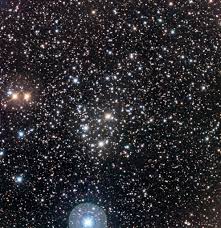STARLOG
A COUPLE OF CLUSTERS IN CASSIOPEIA
OCTOBER 26, 2016
| Observer: |
Tom Campbell |
| Location: |
College Station, Texas (Long: 101°56'W Lat: 33°47'N) |
| Telescope: |
Zhumell 12" f/5 Dobsonian |
OBSERVING SUMMARY:
PLANETS: Saturn
ANDROMEDA: NGC 404
CASSIOPEIA: NGC 129, NGC 136, NGC 457
HERCULES: M13
LYRA: M57
PEGASUS: M15
SCUTUM: M11
If the weather cooperates, my plan for this Halloween is to set up my telescope out in my driveway and allow the kids to take a peek at a couple of bright celestial objects. As sunset came tonight, the clouds began clearing off, so I thought I'd take my telescope out to get a good idea of what objects to show off.
First up was Saturn. At fairly low power (83x) and with the sky still blue, I could easily make out the Cassini Division and Titan. I didn't really spend any time on this tonight. I mainly wanted to see how low I had to point my telescope and how soon I could spot it in the twilight sky. It should make a fine target for the youngest children, who usually finish their trick-or-treating before it gets really dark.
As twilight deepened into darkness, I took aim at M11, the Wild Duck Cluster. I kicked up the power on this one to see how nice I could make it look. 208x filled the eyepiece with dozens of stars. Even though it is sinking into the western muck, it would make a nice object to view.
And what Halloween would be complete without a peek at the Owl Cluster (NGC 457)? 83x gave a good view of this one. Enough power to easily see most of the stars and yet low enough power to stay in the eyepiece for a minute or two before I had to nudge the telescope. This one will be great for some of the kids who show up later in the evening.
I decided to see how a globular cluster would look. Of course, M13 (the Great Hercules Cluster) was my first stop. Hmm. Not so great. I could resolve it to the core, but it was a bit washed out due to being right in the middle of the College Station light dome. So I swung over to a different part of the sky and picked up M15 in Pegasus. Even though it was a bit smaller, this one looked a lot better. It was still a bit washed out in the sky, but with averted vision, hundreds of pinpricks could be seen. Still not as visually impressive as the open clusters, though. But definitely something to fall back on for those who show a genuine interest.
So clusters would be well-covered. How about something a little different? I pointed at M57, the Ring Nebula in Lyra. I kicked up the power to 208x and the view did not disappoint. It was large, bright and glorious, with just a hint of red at the edges. The ring looked thicker in some places than in others, giving it a 3D appearance.
Most of the kids will probably only stop by for a minute or two before wanting to move on to the next house, so that's probably enough targets. Time to look for a few things on my own observing list.
| NGC 129 |
Cassiopeia |
Open Cluster |
8:40pm CST |
 |
At 138x, it looks like it has 3 bright stars in an almost equilateral triangle. The fainter stars make a lopsided ring. |
| |
| NGC 136 |
Cassiopeia |
Open Cluster |
8:55pm CST |
 |
This cluster is not too far from NGC 129. It is somewhat faint. The best view was at 208x, where the six brightest members form a number 2. |
| |
The eyepieces were starting to show signs of dew, although my metal tubed telescope was still dry. I turned the scope to Andromeda to take a peek at Mirach's Ghost (NGC 404) and check the seeing conditions before continuing. It was invisible at 83x, but was fairly easily seen at 136x.
There was a galaxy (NGC 7448) in nearby Pegasus that I'd been wanting to try to find from my back yard. I went to my observing table to look it up in the charts. Hmm. My printed observing list was damp with dew. I better hurry. I found the appropriate chart, looked up its position, and went back to the telescope to take aim. Oh no! In the few minutes I took to find the galaxy on the charts, the sky had completely clouded over. It didn't look like things would clear up anytime soon, so I packed things in for the night.

